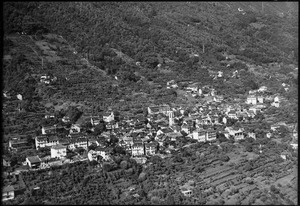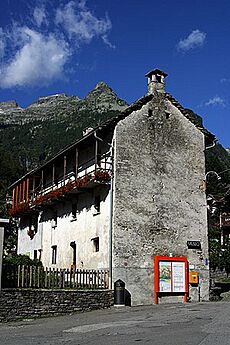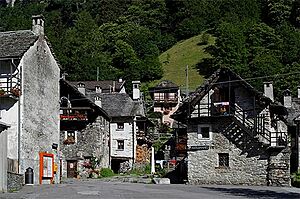Verzasca, Switzerland facts for kids
Quick facts for kids
Verzasca
|
||
|---|---|---|
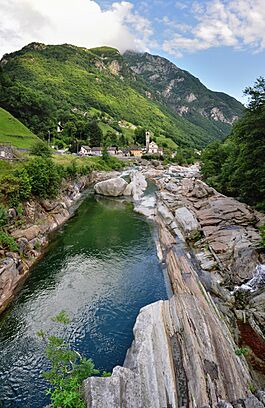
View of the Verzasca at the village of Lavertezzo.
|
||
|
||
| Country | Switzerland | |
| Canton | Ticino | |
| District | Locarno | |
| Area | ||
| • Total | 143.59 km2 (55.44 sq mi) | |
| Elevation | 461 m (1,512 ft) | |
| Population
(Dec 2020 )
|
||
| • Total | 799 | |
| • Density | 5.564/km2 (14.412/sq mi) | |
| Postal code | ||
| Surrounded by | Cevio, Avegno Gordevio, Lavizzara | |
Verzasca is a town in Switzerland. It is located in the Ticino area, which is a canton (like a state or region) of Switzerland. Verzasca is part of the Locarno district.
This town was formed on October 17, 2020. It was created by combining five smaller towns: Vogorno, Sonogno, Corippo, Brione (Verzasca), and Frasco.
Contents
A Look at Verzasca's Past
Verzasca became a new town in 2020. Before that, the people in seven smaller towns in the Valle Verzasca voted to join together. This big change was planned for April 5, 2020, but it was delayed a bit. The towns that joined were Brione, Corippo, Frasco, parts of Lavertezzo and Cugnasco-Gerra, Sonogno, and Vogorno.
Corippo: A Tiny Village
Corippo is a very old village. People first wrote about it in the year 1224. It is known for being one of the smallest towns in Switzerland.
Brione: A Historic Valley Town
In the Middle Ages, Brione was part of a larger community called Verzasca. Later, it joined with another town, Gerra, to form a Vicinanza (a local community). In 1852, Brione and Gerra became separate towns.
Brione was an important town in the upper valley. It took turns with Vogorno in choosing local leaders. The Castello Marcacci, a large house, was built in Brione in the 1600s. It was the summer home for the Marcacci family, who were important leaders.
The Church of Beata Vergine Assunta in Brione is very old. It was built on top of an even older chapel from 1295. The church has beautiful old paintings called frescoes from the 1300s and 1400s. The church started its own local group (parish) before 1518. In 1644, money was set aside to help support a school and a priest.
People in Brione mostly made a living from farming and raising animals. They often moved their animals to different pastures depending on the season. This practice is called seasonal migration. Since the 1300s, many people spent winters with their cattle in the Magadino valley.
Frasco: Farming and Stone
Frasco was first mentioned in records in 1235. For a long time, Frasco and Sonogno were one political town until 1843.
The village church, St. Bernhard, was likely built in the 1300s. The church you see today was built in 1868-1869 on the same spot. In 1518, Frasco and Sonogno formed their own church group, separate from Vogorno. They later split into two separate groups in 1734.
For many centuries, people in Frasco lived by farming and moving their animals seasonally. Starting in 1870, a white marble quarry in Val d'Efra was used to get limestone. In 2000, farming was the main job in Frasco. Most workers traveled to other towns for work. Some old paintings from the 1400s can be seen in the hamlet of Piede della Motta. Many old parts of the town are now protected as historical buildings.
Sonogno: A Valley Museum Town
Sonogno was first mentioned in the year 1200. Like other towns in the area, it was part of the Verzasca community during the Middle Ages. From 1395 to 1843, Sonogno and Frasco were one town.
Sonogno was part of the Vogorno church group until 1519. Then it joined Frasco to form a new group. In 1734, Sonogno became its own independent church group. The main church, St. Maria Loreto, was first mentioned in 1519. It was rebuilt in 1854 and has paintings by Cherubino Patà.
The town's economy was mostly based on raising animals. In summer, cattle grazed in high mountain pastures. In winter, they were moved to warmer areas like Magadino. Because there were not many jobs, many people from Sonogno moved away, especially after 1850. They went to other countries. Today, you can find people whose families came from Sonogno in almost 40 different countries! This movement of people has caused the town's population to get smaller since the mid-1800s.
The Museum of Verzasca was built in Sonogno in 1974. In 2005, farming still provided nearly half of the jobs in the town.
Verzasca's Size and People
After the towns merged, Verzasca covers an area of about 143.59 square kilometers.
The new town of Verzasca has a population of 799 people as of as of December 2020[update].
How the Population Has Changed
This chart shows how the populations of the towns that now make up Verzasca have changed over time:
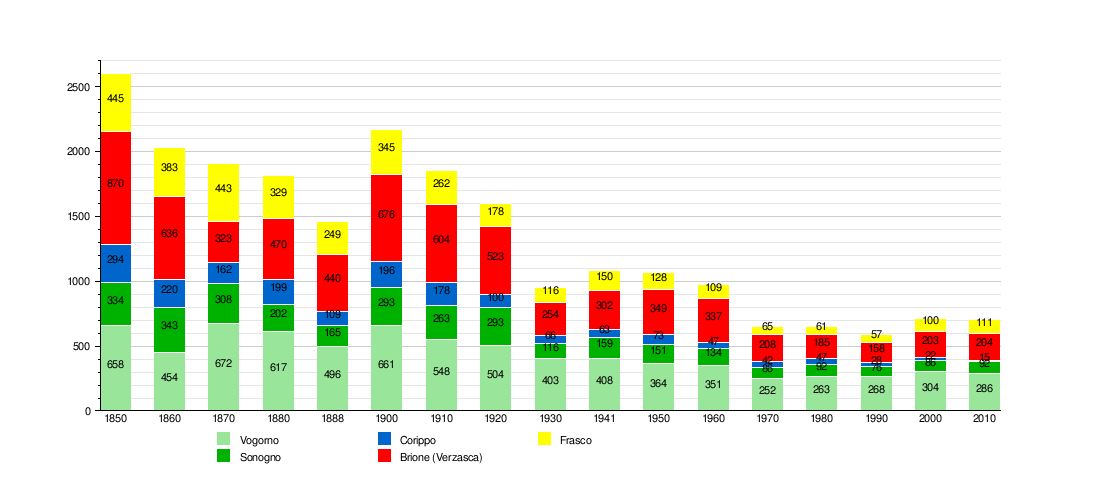
Interesting Places to See
The villages of Corippo, Brione (Verzasca), and Sonogno are very special. They are listed as part of the Inventory of Swiss Heritage Sites. This means they are important historical places that are protected.





